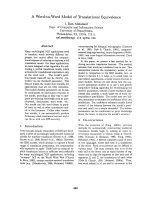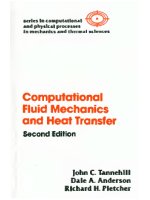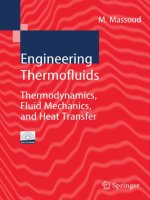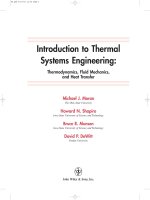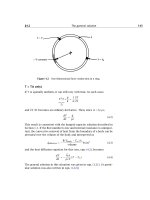A generalised lattice boltzmann model of fluid flow and heat transfer with porous media
Bạn đang xem bản rút gọn của tài liệu. Xem và tải ngay bản đầy đủ của tài liệu tại đây (1.22 MB, 135 trang )
A GENERALISED LATTICE-BOLTZMANN MODEL
OF FLUID FLOW AND HEAT TRANSFER
WITH POROUS MEDIA
XIONG JIE
NATIONAL UNIVERSITY OF SINGAPORE
2007
A GENERALISED LATTICE-BOLTZMANN MODEL
OF FLUID FLOW AND HEAT TRANSFER
WITH POROUS MEDIA
XIONG JIE
B. Eng. HUST
A THESIS SUBMITTED
FOR THE DEGREE OF MASTER OF ENGINEERING
DEPARTMENT OF MECHANICAL ENGINEERING
NATIONAL UNIVERSITY OF SINGAPORE
October 2007
i
ACKNOWLEDGEMENTS
I would like to thank my Supervisors A/Prof. Low Hong Tong and A/Prof. Lee
Thong See for their direction, assistance, and guidance in this interesting area. In
particular, Prof. Low's suggestions and encouragement have been invaluable for the
project results and analysis. I would also like to thank Professor Shu Chang who first
introduced me to the Lattice Boltzmann Method through his lecture notes, which
provided the foundation of my research technique. I am grateful to the National
University of Singapore for the award of a Research Scholarship which financed my
graduate studies.
I also wish to thank Dr. Shi Xing, Dr. Dou Huashu, Dr. Zheng Hongwei, Mr. Li
Jun, Mr. Liu Gang, Mr. Fu Haohuan, Ms. Yu Dan, Ms. Song Ying, Mr. Sui Yi, Mr. Xia
Huaming, Mr. Bai Huixing, Mr. Shi Zhanmin, Mr. Daniel Wong, Mr. Darren Tan, Mr.
Chen Xiaobing, Mr. Li Qingsen, Mr. Zheng Ye, Mr. Figo Pang, and Mr. Patrick Han
from the Computational Bioengineering Lab, who have taught me programming skills,
offered useful expertise, and provided friendship. Special thanks should be given to Mr.
Peter Liu and Ms. Stephanie Lee, who have helped me in many ways in my life and
career path.
Last but not least, I would like to thank my family, Xiong Shilu, Chen Shuying,
and Xiong Wei, whose love has always been with me. I would like to thank all my
friends, who provided great encouragement and support for all these days.
Thank you all who have helped me in this effort.
ii
TABLE OF CONTENTS
ACKNOWLEDGEMENTS i
TABLE OF CONTENTS ii
SUMMARY v
NONMENCLATURE vi
LIST OF FIGURES x
LIST OF TABLES xiv
CHAPTER 1 INTRODUCTION 1
1.1 Background 1
1.2 Literature Review 5
1.2.1 Flow with Porous Media 5
1.2.2 Flow with Temperature 10
1.3 Objectives and Scope of Study 15
CHAPTER 2 STANDARD LATTICE BOLTZMANN METHOD 16
2.1 Lattice Gas Cellular Automata 16
2.2 Basic Idea of LBM 24
2.3 BGK Approximation 27
2.4 Determination of Lattice Weights 34
2.5 Chapman-Enskog Expansion 38
CHAPTER 3 A GENERALIZED LATTICE BOLTZMANN METHOD 46
3.1 Porous Flow Model 46
3.2 Velocity Field 50
iii
3.3 Temperature Field 56
3.4 Boundary Conditions 63
3.4.1 General 63
3.4.2 Bounce-Back Condition 65
3.4.3 Periodic Condition 67
3.4.4 Non-equilibrium Extrapolation 67
CHAPTER 4 RESULTS AND DISCUSSION 70
4.1 Flow in Porous Media 71
4.1.1 Channel with Fixed Walls 71
a. Full Porous Medium 71
b. Partial Porous Medium 77
4.1.2 Channel with a Moving Wall 82
a. Full Porous Medium 82
b. Partial Porous Medium 86
4.1.3 Cavity with a Moving Wall 88
a. Full Porous Medium 88
b. Partial Porous Medium 92
4.2 Forced Convection in Porous Media 94
4.2.1 Channel with a Moving Wall 94
4.2.2 Channel with Fixed Walls 100
a. Full Porous Medium 100
b. Partial Porous Medium 105
iv
CHAPTER 5 CONCLUSIONS AND RECOMMENDATIONS 109
5.1 Conclusions 109
5.2 Recommendation for Further Studies 111
REFERENCES 112
v
SUMMARY
A numerical model, based on the Lattice Boltzmann Method, is presented for
simulating two dimensional flow and heat-transfer in porous media. The drag effect of
the porous medium is accounted by an additional force term. To deal with the heat
transfer, a temperature distribution function is incorporated, which is additional to the
usual density distribution function for velocity. The numerical model was demonstrated
on a few simple geometries filled fully or partially with a porous medium: channel with
fixed walls, channel with a moving wall, and cavity with a moving wall.
The numerical results confirmed the importance of the nonlinear drag force of the
porous media at high Reynolds or Darcy numbers. For flow through a full porous
medium, the results shows an increase of velocity with porosity. The velocity profile for
the partial porous medium, shows a discontinuity of velocity gradient at the interface
when the porosity is very small. At higher Peclet number, the temperature in full and
partial porous media is slightly higher, more so for the case of high heat dissipation at the
wall.
The good agreement of the GLBM solution with finite difference solutions and
experimental results demonstrated the accuracy and reliability of the present model.
Previous studies have been mainly focused on the effect of different Reynolds and Darcy
numbers. In this thesis, it is extended to investigate the effect of different porosity and
Peclet number.
vi
NOMENCLATURE
rΔ discrete displacement
n occupation number
ν
shear viscosity
ε
porosity for full porous media
K permeability
eff
ν
effective viscosity
Ω
collision operator
s
c speed of sound
i
e particle velocity
i
f
density distribution function
λ
expansion parameter
t time
x
Cartesian coordinate, horizontal
y
Cartesian coordinate, vertical
X
non-dimensional Cartesian coordinate, horizontal
Y
non-dimensional Cartesian coordinate, vertical
η
index of spatial dimension
d number of spatial dimension
b number of spatial dimension in Fermi-Dirac distribution
z number of links
Z
number of discrete particle velocity
vii
N number of nodes
U non-dimensional velocity
0
u characteristic velocity
L characteristic length
H characteristic height
h height
m
k thermal conductivity
e
k stagnant thermal conductivity
d
k dispersion thermal conductivity
m particle mass
ρ
density
p
pressure
β
thermal expansion coefficient
l length
α
thermal diffusivity
m
α
effective thermal diffusivity
t
δ
time step
x
δ
lattice space
u x-direction velocity component
v y-direction velocity component
F total body force
G body force
viii
g
gravitational acceleration
T temperature
0
T reference temperature
i
T temperature distribution function
σ
heat capacity ratio between solid and fluid
i
w weight coefficient
p
d
diameter of particle
p
c heat capacity
F
ε
geometric function
τ
relaxation time in LBM for velocity field
'
τ
relaxation time in LBM for temperature field
b
τ
relaxation time in LBM with BGK approximation
R
gas constant
D spatial dimension
B
boundary
Re Reynolds number
Kn Knudsen number
M
a Mach number
Da Darcy number
Je viscosity ratio
Pr
Prandtl number
R
a Rayleigh number
ix
Pe
Peclet Number
Subscripts
i
discrete velocity direction
eff
effective
Superscripts
eq
equilibrium
x
LIST OF FIGURES
Figure 1.1 Three levels of natural phenomenon description 3
Figure 2.1 The domain geometry is a 5 x 5 torus of the FHP with
D2Q6 model 19
Figure 2.2 Sketches of the some common (1)DdQ N
+
lattice models 21
Figure 3.1 Sketch of the boundary conditions 64
Figure 3.2 Sketch of wall boundary conditions for D2Q9 Model 66
Figure 4.1 Grid independence study of velocity in channel with full porous medium
for Da =
5
10
−
and
ε
= 0.1 and Re = 10.0 with different mesh size. 75
Figure 4.2 Velocity profile in channel with full porous medium for
Da =
5
10
−
and
ε
= 0.1 at different Re 75
Figure 4.3 Velocity profile in channel with full porous medium for
Re = 0.1 and
ε
= 0.1 at different Da 76
Figure 4.4 Velocity profile in channel with full porous medium for
Da =
4
10
−
and Re =0 .1 at different
ε
76
Figure 4.5 Velocity profile in channel with partial porous medium for
Re = 10.0 and
ε
=
3
10
−
at different Da 80
Figure 4.6a Velocity profile in channel with partial porous medium for
Da =
2
10
−
and
ε
=
3
10
−
at different Re 80
Figure 4.6b Velocity profile in channel with partial porous medium for
Da =
2
10
−
and
ε
=
3
10
−
at different Re 81
Figure 4.7 Velocity profile in channel with partial porous medium for
Da =
2
10
−
, and Re = 10.0 at different
ε
81
xi
Figure 4.8 Velocity profile in channel with full porous medium for
Da =
2
10
−
and
ε
=
2
10
−
at different Re 84
Figure 4.9 Velocity profile in channel with full porous medium for
Re = 10.0 and
ε
=
2
10
−
at different Da 85
Figure 4.10 Velocity profile in channel with full porous medium for
Da = 0.1 and Re = 0.1at different
ε
85
Figure 4.11 Velocity profile in channel with partial porous medium for
Da =
2
10
−
, and Re = 10.0 at different
ε
87
Figure 4.12 Horizontal velocity profile in cavity with full porous medium
for Re = 0.1 and
ε
= 0.1 at different Da 90
Figure 4.13 Vertical velocity profile in cavity with full porous medium
for Re = 0.1 and
ε
= 0.1 at different Da 90
Figure 4.14 Horizontal velocity profile in cavity with full porous medium
for Da=
3
10
−
and
ε
=0.1 at different Re 91
Figure 4.15 Vertical velocity profile in cavity with full porous medium
for Da =
3
10
−
and
ε
= 0.1 at different Re 91
Figure 4.16 Horizontal velocity profile in cavity with full porous medium
for Da =
2
10
−
and Re = 10.0 at different
ε
93
Figure 4.17 Temperature profile in channel with porous medium for
Da = 0.1,
ε
= 0.7 and Ra = 100.0 at different Re 97
Figure 4.18 Velocity profile in channel with porous medium for
Da = 0.1,
ε
= 0.7 and Ra = 100.0 at different Re 98
Figure 4.19 Velocity profile in channel with porous medium for
xii
Re = 5.0,
ε
= 0.7 and Ra = 100.0 at different Da 98
Figure 4.20 Velocity profile in channel with porous medium for
Re = 5.0, Da = 0.01 and Ra = 100.0 at different
ε
99
Figure 4.21 Temperature profiles along bottom of the channel with porous
medium for Da =
2
10
−
,
ε
= 0.8 and
T
y
∂
∂
= 1.0 at different Pe 99
Figure 4.22 Temperature profiles along the vertical midline of the
channel with porous medium for Da =
2
10
−
,
ε
= 0.8 and
T
y
∂
∂
= 1.0 at different Pe 100
Figure 4.23 Temperature profiles along bottom of the channel with porous
medium for Da =
4
10
−
,
ε
=
2
10
−
and
T
y
∂
∂
= 0.1 at different Pe 103
Figure 4.24 Temperature profiles along the vertical midline of channel
with porous medium for Da =
4
10
−
,
ε
=
2
10
−
and
T
y
∂
∂
= 0.1
at different Pe 103
Figure 4.25 Temperature profiles along bottom of the channel with porous
medium for Da =
4
10
−
,
ε
=
2
10
−
and
T
y
∂
∂
= 0.1 at different Pe 104
Figure 4.26 Temperature profiles along the vertical midline of channel
with porous medium for Da =
4
10
−
,
ε
=
2
10
−
and
T
y
∂
∂
= 0.1
at different Pe 104
Figure 4.27 Temperature profiles along the bottom of channel with partial
xiii
porous medium for Da =
4
10
−
,
ε
=
2
10
−
and
T
y
∂
∂
= 0.1
at different Pe 107
Figure 4.28 Temperature profiles along the vertical midline of channel
with partial porous medium for Da =
4
10
−
,
ε
=
2
10
−
and
T
y
∂
∂
= 0.1 at different Pe 107
Figure 4.29 Temperature profiles along channel bottom with Da =
4
10
−
,
ε
=
2
10
−
and
T
y
∂
∂
= 0.1 at different Pe 108
Figure 4.30 Temperature profiles along midline of channel height with
Da =
4
10
−
,
ε
=
2
10
−
and
T
y
∂
∂
= 0.1 at different Pe 108
xiv
LIST OF TABLES
Table 2.1 Some main parameters of the most common ( 1)DdQ Z
+
lattices 37
CHAPTER 1 INTRODUCTION
1
CHAPTER 1
INTRODUCTION
1.1 Background
Transport phenomena in porous media is a subject of wide interdisciplinary
concern. It has various applications in fluid mechanics, condensed matter, and
environment sciences (Succi 2001). There are many fluid problems where an external
force or internal force should be considered, such as multi-phase or multi-component
fluids. To obtain the correct hydrodynamics, the force term in simulation model should
be treated appropriately.
Due to many engineering applications such as electronic and transportation
cooling, drying process, porous bearing, solar collectors, heat pipes, nuclear reactors, and
crude oil extraction, the characteristics of fluid flow and heat transfer at the interface
region of mixed system with a porous medium and an adjacent fluid domain have
attracted attentions of researchers.
The problems discussed above have been studied both experimentally and
theoretically. A generalized model was recently developed in modeling flow transport in
porous media. In these models, the drag forces and the fluid forces were considered in the
momentum equation (Tien 1990, Hsu and Cheng 1990, and Nithiarasu et al. 1997). The
Darcy, Brinkman-extended Darcy, and Forchheimer-extended Darcy models can be taken
as the limiting generalized model. Additionally, the generalized models mentioned above
can be used to model transient flow in porous media. Since the analytical solutions of the
flows in porous media are difficult to obtain, usually only the approximate numerical
solutions can be acquired. Besides the experimental and analytical investigations, many
CHAPTER 1 INTRODUCTION
2
computational methods have been presented to solve the problems of fluid flow and heat
transfer in porous media. Most conventional simulations use the standard approaches
based on the discretizations of some semi-empirical models, such as the finite-element
methods, the finite-difference method, and the finite-volume methods (Nithiarasu et al.
1997, Hickox and Gartling 1985, Nishimura et al. 1986, Gartling et al. 1996, Nithiarasu
et al. 1998, and Amiri 2000).
The simulation of physical phenomenon can be described at three levels:
macroscopic, mesoscopic and microscopic as shown in Figure 1.1 (Shu 2004). As most
numerical approaches, differential equations are used to model the variations such as
variations of velocity or temperature. These quantities describe the mean behavior of
molecules on discretizations of the domain. In this case, the macroscopic scale is based
on discretization of macroscopic continuum equations.
The correspondence scale is microscopic scale or molecular dynamics method.
They are based on atomic representation with complicated molecule collision rules and
describe the molecular behavior of the phenomena with more accurate results. At this
scale, the questions that macroscopic can not solve could be solved by microscopic.
Obviously, comparing to the macroscopic scale computation, more computational time is
needed for a microscopic computation. Using microscopic scale to simulate some
physical processes may take months. Thus, the application size is indeed reduced.
An intermediate scale is the mesoscopic scale which is based both on microscopic
models and mesoscopic kinetic equations. It is defined as larger than an atom, but smaller
than anything manipulated with human hands (Shu 2004). At mesoscopic scale, pseudo
fluid particles are defined as moving and interacting in an imagined world obtained by a
CHAPTER 1 INTRODUCTION
3
discretization of the real world, according to a set of simplified and relevant rules.
Although this representation is far from the reality, it has been shown to be effective to
recover complicated physical phenomenon. Informally, it is called Cellular Automata
(CA) (Chopard and Droz 1998).
As an alternative computational method, the CA and later developed Lattice
Boltzmann Method (LBM) have gained much progress since last decade. Some CA
models have been successfully simulated various phenomena, such as diffusion processes
(Chopard and Droz 1998). Next, CA models are used to simulate more complicated
phenomena such as some fluid flows (Succi 2001). These models are called Lattice
Boltzmann Method (LBM), of which details will be introduced in the following chapters.
Both CA and LBM use regular and uniform grids, such as lattices. This particular
structure is usually represented as regular arrays which are used for various functions.
Because the aim is to build more efficient programs, the reusability or maintenance is
ignored in simulation. For instance, a modification of the lattice topology implies many
changes traditionally. Hence, an efficient and simulation oriented implementation is a
must.
Figure 1.1 Three levels of natural phenomenon description from (Shu 2004)
CHAPTER 1 INTRODUCTION
4
By tracking the evolution of the distribution functions of the microscopic fluid
particles, LBM is different from traditional methods which solve the usual continuum
hydrodynamic equations (Dupuis 2002). The kinetic nature of LBM introduces some
important and even unique features, such as the easy modeling of interactions among the
fluid and porous medium. Originally, in LBM simulations only mass and momentum
conservations were considered. However, the thermal effects in fluid flows need to be
considered in many applications for its importance and critical ability.
CHAPTER 1 INTRODUCTION
5
1.2 LITERATURE REVIEW
1.2.1 Flow with Porous Media
The LBM has been applied to the study of flows in porous media since the 1980s
(Balasubramanian et al. 1987 and Rothman 1988). Reviews of the subject may be found
in Chen and Doolen (1998) and Nield and Bejan (1992). Further development of LBM to
simulate flows in porous media have been carried out by many authors (Succi 1989,
Adrover and Giona 1996, Koponen et al 1998, Langass and Grubert 1999, Singh and
Mohanty 2000, Bernsdorf et al. 2000, and Kim et al. 2001).
There are mainly three scales of simulation involved in flow of porous media: the
representative elementary volume (REV) scale, domain scale, and pore scale (Guo and
Zhao 2002d). The REV scale is defined as the minimum element which the
characteristics of a porous flow present. The REV scale is much smaller than the domain
scale but much larger than the pore scale. In conventional methods, due to the complex
structure of a porous medium, some semi-empirical models were used in the flow in
porous media. They were based on the volume-averaging at the REV scale.
Usually, the LBM with pore scale and REV scale methods have been used in
simulating the porous flows (Guo and Zhao 2002d). In the pore scale method, the fluid in
the pores of the medium is directly modeled by the standard Lattice Boltzmann Equation
(LBE). LBM’s kinetic nature makes it very suitable for microscopic interactions in fluid.
Additionally, the full bounce back rule for no-slip boundary condition, called the no-slip
bounce-back rule, makes simulation of flow in porous media by suitable LBM. The main
advantage of this method is that the local information of the flow can be obtained and
CHAPTER 1 INTRODUCTION
6
used to study macroscopic relations. In fact, the pore-scale method is the most natural
way to simulate flows in porous flows by LBM.
However, there are some disadvantages of the pore scale method. One of the main
disadvantages is that this scale required the geometric information in detail (Guo and
Zhao 2002d). However, the computation domain size has to be limited to reduce usage of
the computer resources. This is because each pore should contain several lattice nodes.
Therefore the pore scale method is not suitable for a large domain size flow.
Another disadvantage of the pore scale method is that the flow superficial velocity,
such as the volume-averaged velocity of the flow, cannot be too high. The volume-
averaged velocity is defined as
f
uu
ε
=
, where
f
u is the pure fluid velocity, u is the
fluid averaged velocity, and
ε
is the medium porosity. If the aim is to simulate the
interstitial fluid in the pores of the system, the volume-averaged velocity cannot be too
high for LBM’s limit of low Mach number condition. Therefore the pure fluid velocity
f
u can not be high.
The other method to simulate the porous fluid flow by LBM is using the REV
scale (Guo and Zhao 2002d). This is utilized by revising the standard LBE by adding an
additional term to account for the influence of the porous medium (Dardis and
McCloskey 1998, Spaid and Phelan 1997, Freed 1998, Kang et al. 2002, Spaid and
Phelan 1998, and Martys 2001). In this method, the detailed medium structure and
direction are usually ignored, including the statistical properties of the medium into the
model. Thus, it is not suitable to obtain detailed pore scale flow information. But the
LBM with REV scale could be used for porous medium system of large size. Some
examples of the models with REV scales are discussed below.
CHAPTER 1 INTRODUCTION
7
Dardis and McCloskey (1998) proposed a Lattice Boltzmann scheme for the
simulation of flow in porous media by introducing a term describing the no-slip boundary
condition. By this approach, the loss of momentum resulting from the solid obstacles is
incorporated into the evolution equation. A number ordered parameter of each lattice
node related to the density of solid scatters is used to represent the effect of porous
medium solid structure on the hydrodynamics. This method removes the need to obtain
spatial averaging and temporal averaging, and avoid the microscopic length scales of the
porous media.
Spaid and Phelan (1997) proposed a SP model of Lattice Boltzmann Method
which is based on the Brinkman equation for single-component flow in heterogeneous
porous media. The scheme uses a hybrid method in which the Stokes equation is applied
to the free domains; and the Brinkman equations is used to model the flow through the
porous structures. The particle equilibrium distribution function was modified to recover
the Brinkman equation. In this way, the magnitude of momentum at specified lattice
nodes is reduced and the momentum direction is kept.
Freed (1998) proposed a similar approach using an additional force term to
simulate flows through a resistance field. An extension term was implemented to modify
the standard LBGK model, which results in a local resistance force appropriate for
simulating the porous medium region. Simulation results for uniform flow confirmed that
the LBGK algorithm yields the satisfied and precise macroscopic behaviors. Also, it was
observed that the fluid compressibility simulated by LBM influences its ability to
simulate incompressible porous flows.
CHAPTER 1 INTRODUCTION
8
Later the SP model was combined with a multi-component Lattice Boltzmann
algorithm to extend for multi-component system (Spaid and Phelan 1998). The method
was developed by introducing a momentum sink to simulate the multi-component fluid
flow of a fiber system. It was confirmed that the model is useful to simulate the multi-
component fluid flow system. By using the LBM, the complex interface between two
immiscible fluids can be easily dealt with those without special treatment of the interface
by tracking algorithm.
Shan and Chen (1993) combined the Stokes/Brinkman LBM with the algorithm to
model the multi-component infiltration of the fiber microstructure. The developed LBM
is suitable to simulate flows containing multiple phases and multi-components
immiscible fluids of different masses in constant temperature. One of the main
improvements of this model is to include a dynamical temperature. The component
equilibrium state can have a non-ideal gas state equation at a given temperature showing
phase transitions of thermodynamics.
The SP model was improved to generalize the Lattice Boltzmann Method by
introducing an effective viscosity into the Brinkman equation to improve the accuracy
and stability (Martys 2001). The approach can describe the general case when fluid
viscosity is not the same as the effective viscosity. By implementing the dissipative
forcing term into a linear body force term, the validity of the Brinkman equation is
extended to a larger range of forcing and effective viscosity. This model eliminates the
second order errors in velocity and improves stability over the SP model. It also improves
the accuracy of other applications of the model, such as fluid mixtures.
CHAPTER 1 INTRODUCTION
9
The discussed Brinkman model and improved models have been proved to be an
easily implemented and a computationally efficient method to simulate fluid flows in
porous media. However, these models are based on some relative simple semi-empirical
models such as Darcy or Brinkman models. Therefore they have some intrinsic
limitations. Vafai and Kim (1995) pointed out that if there is no convective term, the
drive to development of the flow field does not exist. Since Brinkman model does not
contain the nonlinear inertial term, it is only suitable for low-speed flows.
Recently, a generalized Lattice Boltzmann Method based on general Lattice
Boltzmann Equations (GLBE) called DDF (double density distribution) LBM by Guo
and Zhao (2002d) was developed for isothermal incompressible flows. It is used to
overcome the limitations of the Darcy or Brinkman model for flows in porous media.
This generalized LBM could automatically deal with the interfaces between different
media without applying any additional boundary conditions. This enables the DDF LBM
suitable to model flows in a medium with a variable porosity. The DDF LBM is based on
the general Navier–Stokes model and considered the linear and nonlinear matrix drag
components as well as the inertial and viscous forces. The inertial force term of DDF
LBM is based on a recently developed method (Guo et al. 2002c), and the newly defined
equilibrium distribution function is modified to simulate the porosity of the medium.
Because the GLBE is very close to the standard LBE, the DDF LBM solvers for the
generalized Navier-Stokes equations are similar to the standard LBM solvers for the
Navier-Stokes equations (Nithiarasu et al. 1997 and Vafai and Tien, 1981).
Furthermore, the force term in GLBE was used to simulate the interaction
between the fluid and the media. It was equivalent to implement an effective boundary

